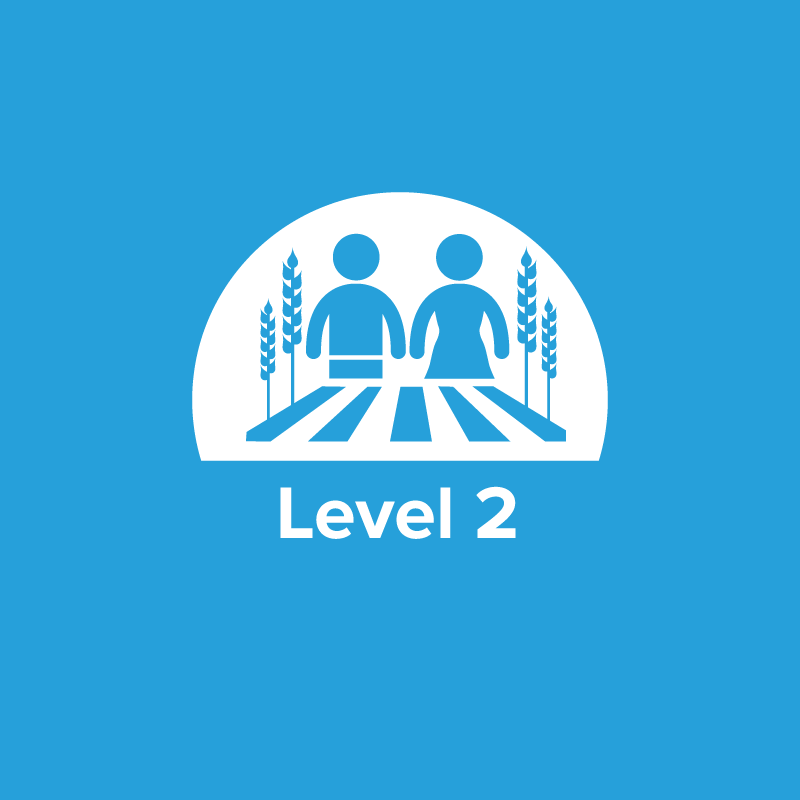Journey 2050 Lesson 2: Soil Nutrients (Grades 9-12)
Students will identify nitrogen, potassium and phosphorus as primary soil nutrients necessary in the production of abundant and healthy foods, describe various methods of replenishing soil nutrients that have been depleted by plant growth, discover how overall plant health impacts a plant’s ability to resist disease and pests and describe what best management practices are in agriculture to improve overall sustainability.

Background
Lesson Activities
Recommended Companion Resources
Credits
Author
Lindsey Verhaeghe, Andrea Gardner, Debra Spielmaker, and Sara Hunt | National Center for Agricultural Literacy (NCAL) and Nutrien
Acknowledgements
The Journey 2050 program was originally developed by Nutrien in collaboration with Calgary Stampede, Alberta Canola Producers Commission, Nutrients for Life Foundation, and Agriculture in the Classroom Canada. Authors and contributors were drawn from each of these organizations under the direction of Lindsey Verhaeghe (Nutrien) and Robyn Kurbel (Calgary Stampede.) The lessons were updated and revised in 2017 and 2022 with contributions from the original J2050 Steering Committee, the National Center for Agricultural Literacy, and the National Agriculture in the Classroom Organization.
Sources
- https://en.wikipedia.org/wiki/Bushel
- https://wagrains.org/wheat/
- https://www.ers.usda.gov/webdocs/publications/41880/33132_ah697_002.pdf
- https://en.wikipedia.org/wiki/Acre
- http://www.scidev.net/sub-saharan-africa/agriculture/news/fertile-soil-increases-crop-yields.html
- https://www.topcropmanager.com/the-role-of-fertilizer-in-growing-the-worlds-food-10387/
Standards
Texas Content Area Standards
-
Principles of Agriculture, Food, and Natural Resources: 130.2.c.1
The student demonstrates professional standards/employability skills as required by business and industry. The student is expected to:
- Principles of Agriculture, Food, and Natural Resources: 130.2.c.1.B: apply competencies related to resources, information, interpersonal skills, problem solving, critical thinking, and systems of operation in agriculture, food, and natural resources.
-
Principles of Agriculture, Food, and Natural Resources: 130.2.c.4
The student explains the historical, current, and future significance of the agriculture, food, and natural resources industry. The student is expected to:
- Principles of Agriculture, Food, and Natural Resources: 130.2.c.4.B: analyze the scope of agriculture, food, and natural resources and its effect upon society.
- Principles of Agriculture, Food, and Natural Resources: 130.2.c.4.C: evaluate significant historical and current agriculture, food, and natural resources developments.
- Principles of Agriculture, Food, and Natural Resources: 130.2.c.4.F: compare and contrast issues impacting agriculture, food, and natural resources such as biotechnology, employment, safety, environment, and animal welfare issues.
- Principles, of Agriculture, Food, and Natural Resources: 130.2.c.4.D: identify potential future scenarios for agriculture, food, and natural resources systems, including global impacts.
-
Principles of Agriculture, Food, and Natural Resources: 130.2.c.6
The student demonstrates appropriate personal and communication skills. The student is expected to:
- Principles of Agriculture, Food, and Natural Resources: 130.2.c.6.A: demonstrate written and oral communication skills appropriate for formal and informal situations such as prepared and extemporaneous presentations.
- Principles of Agriculture, Food, and Natural Resources: 130.2.c.6.B: demonstrate effective listening skills appropriate for formal and informal situations.
-
Principles of Agriculture, Food, and Natural Resources: 130.2.c.10
The student develops technical knowledge and skills related to soil systems. The student is expected to:
- Principles of Agriculture, Food, and Natural Resources: 130.2.c.10.A: identify the components and properties of soils.
-
Economics with Emphasis on the Free Enterprise System and Its Benefits: 113.31.c.1
Economics. The student understands the concepts of scarcity and opportunity costs.
- Economics with Emphasis on the Free Enterprise System and Its Benefits: 1.A: The student is expected to explain why scarcity and choice are basic economic problems faced by every society.
- Economics with Emphasis on the Free Enterprise System and Its Benefits: 1.C: The student is expected to describe the economic factors of production: land, labor, capital, and entrepreneurship.
-
Economics with Emphasis on the Free Enterprise System and Its Benefits: 113.31.c.23
Social studies skills. The student uses problem-solving and decision-making skills, working independently with others.
- Economics with Emphasis on the Free Enterprise System and Its Benefits: 23: The student is expected to use problem-solving and decision-making processes to identify a problem, gather information, list and consider options, consider advantages and disadvantages, choose and implement a solution, and evaluate the effectiveness of the solution.
-
World Geography Studies: 113.43.c.8
Geography. The student understands how people, places, and environments are connected and interdependent.
- World Geography Studies: 8.A: The student is expected to compare ways that humans depend on, adapt to, and modify the physical environment, including the influences of culture and technology.
-
English I: 110.36.c.1
Developing and sustaining foundational language skills: listening, speaking, discussion, and thinking--oral language. The student develops oral language through listening, speaking, and discussion.
- English I: 1.A: The student is expected to engage in meaningful and respectful discourse by listening actively, responding appropriately, and adjusting communication to audiences and purposes.
-
English II: 110.37.c.1
Developing and sustaining foundation language skills: listening, speaking, discussion, and thinking--oral language. The student develops oral language through listening, speaking, and discussion.
- English II: 1.A: The student is expected to engage in meaningful and respectful discourse by listening actively, responding appropriately, and adjusting communication to audiences and purposes.
-
English III: 110.38.c.1
Developing and sustaining foundational language skills: listening, speaking, discussion, and thinking--oral language. The student develops oral language through listening, speaking, and discussion.
- English III: 1.A: The student is expected to engage in meaningful and respectful discourse when evaluating the clarity and coherence of a speaker's message and critiquing the impact of a speaker's use of diction and syntax.
-
English IV: 110.39.c.1
Developing and sustaining foundational language skills: listening, speaking, discussion, and thinking--oral language. The student develops oral language through listening, speaking, and discussion.
- English IV: 1.A: The student is expected to engage in meaningful and respectful discourse when evaluating the clarity and coherence of a speaker's message and critiquing the impact of a speaker's use of diction, syntax, and rhetorical strategies.
-
Environmental Systems: 112.37.c.9
Science concepts. The student knows the impact of human activities on the environment.
- Environmental Systems: 9.E: The student is expected to evaluate the effect of human activities, including habitat restoration projects, species preservation efforts, nature conservancy groups, hunting, fishing, ecotourism, all terrain vehicles, and small personal watercraft, on the environment.
-
Environmental Systems: 112.37.c.5
Science concepts. The student knows the interrelationships among the resources within the local environmental system.
- Environmental Systems: 5.A: The student is expected to summarize methods of land use and management and describe its effects on land fertility.
- Environmental Systems: 5.C: The student is expected to document the use and conservation of both renewable and non-renewable resources as they pertain to sustainability.
-
Turf Grass Management: 130.22.c.4
The student identifies and implements common cultural and physiological requirements for cool and warm season turf grass establishment. The student is expected to:
- Turf Grass Management: 130.22.c.4.D: determine the importance of site grading for water movement.
-
Turf Grass Management: 130.22.c.5
The student identifies and implements common cultural and physiological requirements for cool and warm season turf grass maintenance. The student is expected to:
- Turf Grass Management: 130.22.c.5.G: develop fertilization plans that address turf grass needs and environmental concerns.
-
Advanced Plant and Soil Science: 130.25.c.8
The student explains the relationship of biotic and abiotic factors within habitats and ecosystems. The student is expected to:
- Advanced Plant and Soil Science: 130.25.c.8.C: evaluate the impact of human activity such as pest control, hydroponics, and sustainable agriculture on ecosystems.
-
Advanced Plant and Soil Science: 130.25.c.9
The student analyzes soil science as it relates to food and fiber production. The student is expected to:
- Advanced Plant and Soil Science: 130.25.c.9.A: explain soil formation.
- Advanced Plant and Soil Science: 130.25.c.9.B: evaluate the properties and nature of soils.
- Advanced Plant and Soil Science: 130.25.c.9.C: recognize the importance of conservation of soil and agencies involved in conservation.
-
Advanced Plant and Soil Science: 130.25.c.10
The student describes the relationship between resources within environmental systems. The student is expected to:
- Advanced Plant and Soil Science: 130.25.c.10.A: summarize methods of land use and management.
- Advanced Plant and Soil Science: 130.25.c.10.C: explore the use and conservation of renewable and non-renewable resources.
- Advanced Plant and Soil Science: 130.25.c.10.D: analyze and evaluate the economic significance and interdependence of components of the environment.
- Advanced Plant and Soil Science: 130.25.c.10.E: evaluate the impact of human activity and technology on soil fertility and productivity.
- Advanced Plant and Soil Science: 130.25.c.10.F: analyze and describe the effects on environments of events such as fire, hurricanes, deforestation, mining, population growth, and urban development.
-
Environmental Systems: 112.50.c.6
Science concepts. The student knows the interrelationships among the resources within the local environmental system. The student is expected to:
- Environmental Systems: 112.50.c.6.A: compare and contrast land use and management methods and how they affect land attributes such as fertility, productivity, economic value, and ecological stability
- Environmental Systems: 112.50.c.6.C: document the use and conservation of both renewable and non-renewable resources as they pertain to sustainability
-
Environmental Systems: 112.50.c.11
Science concepts. The student understands how individual and collective actions impact environmental systems. The student is expected to:
- Environmental Systems: 112.50.c.11.A: evaluate the negative effects of human activities on the environment, including overhunting, overfishing, ecotourism, all-terrain vehicles, and personal watercraft
- Environmental Systems: 112.50.c.11.B: evaluate the positive effects of human activities on the environment, including habitat restoration projects, species preservation efforts, nature conservancy groups, game and wildlife management, and ecotourism
 Plants require 17 essential nutrients. The primary nutrients are nitrogen (N), phosphorus (P) and potassium (K). Each nutrient does many things for the plant but the basics are these:
Plants require 17 essential nutrients. The primary nutrients are nitrogen (N), phosphorus (P) and potassium (K). Each nutrient does many things for the plant but the basics are these: